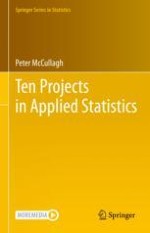Abstract
This chapter offers advice on technical writing, and the inclusion of tables and graphs in reports.
The purpose of a table or graph is to advance the narrative by drawing attention to the most important patterns or features in the data such as the nature and direction of various effects. A graph is helpful for presentation only if it illustrates an important effect clearly. A graph of residuals may be helpful for model checking, and may be mentioned in presentation, but, unless it is explicitly requested in a homework exercise, it is seldom included as part of the report. In most factorial designs, whether balanced or otherwise, one-way and two-way tables of averages are often useful as a partial summary of conclusions. The relevance of the graph to the conclusions must be spelled out in the accompanying narrative.
Computer output: (i) How to adapt computer output for inclusion in the text; (ii) From the computer-generated analysis-of variance table, list only the parts that are relevant to your analysis. It is your job as author, statistician and expert to judge what is relevant and what is not. (iii) The number of decimal digits for regression coefficients, standard errors, F-ratios, p-values; (iv) Labelling of parameters and factor levels in tables; (v) Every parameter has a physical interpretation. Do not pass up the opportunity to remind the reader what the physical interpretation of the logistic coefficient \(\hat \beta = -0.684\) is in the context of the problem. It means that the odds of disease in the treatment group are one half the odds in the control group.
Grammar and word usage: substitute versus replace, use versus usage; verb tense; verbs for statistical and computational activities;
Technical matters: (i) Response transformation must always be considered; (ii) Experimental units versus observational units; it is the number of experimental units that governs the degrees of freedom for treatment-effect contrasts; (iii) Beware the pitfalls of automated model-selection procedures in situations for which they are not designed; e.g. factorial models; (iv) How to report interactions. (v) p-values: best avoided, but if you must report one, be sure to state the null hypothesis being tested.
